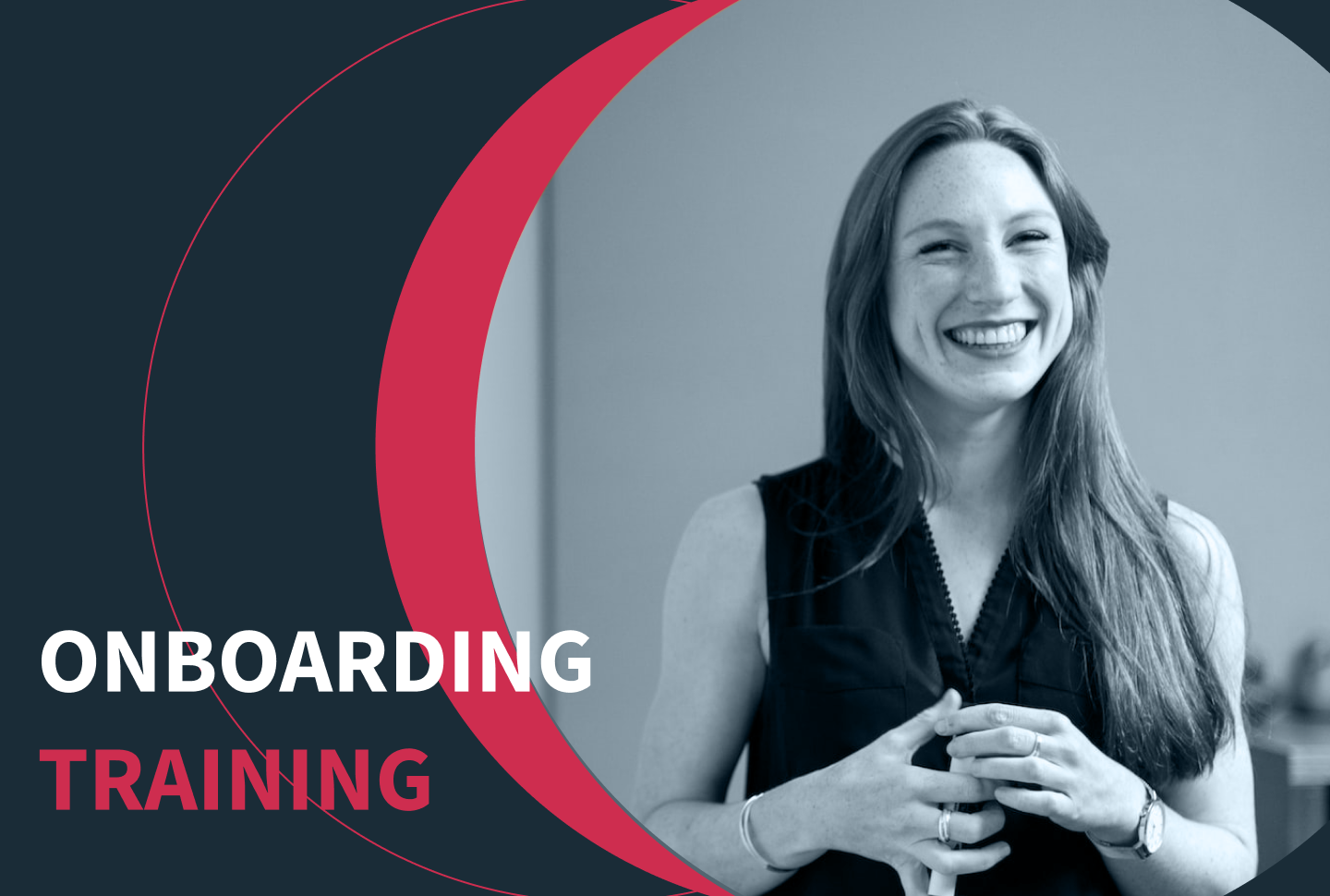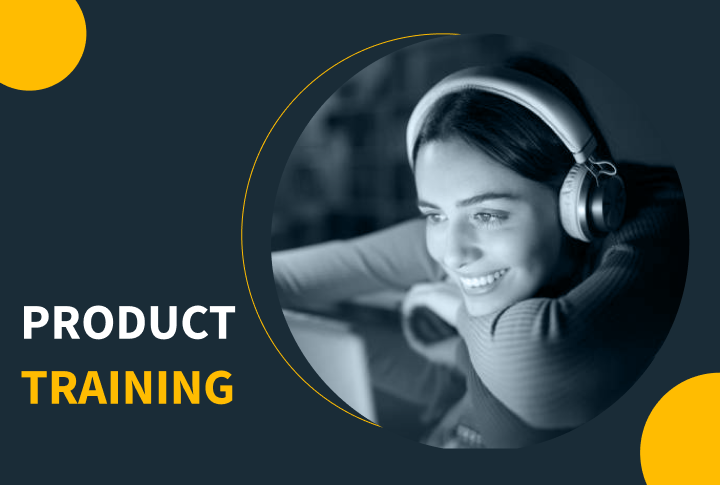This document covers the whole process of creating digital workplace learning content: from the initial discussions with L & D teams and SMEs, to the launch of the digital learning solution. You’ll find out about potential pitfalls, and how to avoid them, by having a clear agreed plan, with key sign-off moments. You’ll also get some great ideas for creating engaging and effective digital content.
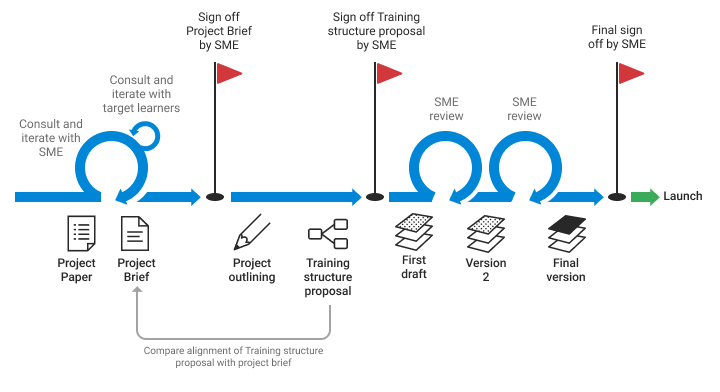
Background
We’re surrounded by technology in our lives, whoever we are and wherever we work. Our expectations of training and learning at work may differ but by now, most people will have acquired the ability to discover information via Google and find out how to perform an action through YouTube. Most of us are self-directed, to varying degrees, but we certainly expect content to be focused, easy to access and to do what it says on the tin. As L & D professionals, it’s our job to provide this.
A fine art
L & D teams work with others to create learning: this can be internal or external, but usually involves working with subject matter experts (SMEs). This group has a specific task or knowledge area that they need to convey to all or part of the workforce. These stakeholders come with “content” which may be in a variety of forms.
Working with stakeholders to help them achieve their goals is a fine art. They come armed with information, experience and a war chest of anecdotal learning evidence. In reality, the content that they bring often needs a lot of work to become good digital learning.
Steering the stakeholder to an appropriate, effective solution can be very tricky, and requires careful handling. Remember that it’s easier to persuade with a good suggestion, than alienate by finding fault with existing content.
Each situation will be different:
- You may need to develop a course, using the content as a starting point
- You may need to develop specific information, such as job aids, which are accessible at the point of need
- You may be designing a more reflective type of learning, such as a questionnaire or checklist which will be used in a face to face situation, as part of a broader learning plan
The world of L & D is changing fast: L & D professionals no longer simply source quite generic, off the shelf content to meet a defined business need. Now, it is possible and desirable to pin down precisely what is needed in which area of the business, and create, or contribute to the creation of appropriate, targeted solutions.
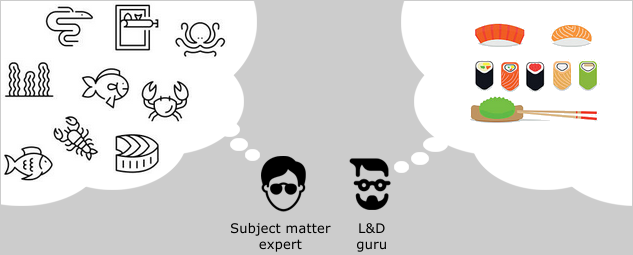
Project paper and project brief
Key Questions
Before we scope the content, we need to ask some basic questions:
1. What is the one key challenge you are addressing?
There may be several challenges, but you need to find the most urgent and compelling. It could be:
a) Regulatory: e.g. mandatory training, GDPR
b) Issues with performance
c) Change of mind-set: e.g. business is undergoing transformation
2. To what scale does it impact your primary audience?
The extent of the training requirement may vary, from a brief refresher to an intensive mandatory course. Some possibilities:
a) Induction to the subject
b) Some specific key information
c) Updating training
d) Complete reframing of a subject
When there is a major change in an organisation, with transformation of procedures and attitudes, the digital learning will ideally be part of a bigger initiative. The changes will come about through a blended approach: some face to face training, some e-learning, some coaching.
3. How will success be measured?
It’s vital to get your stakeholders to identify success measures. This could be:
- The passing of a test of learning, or achieving a certain percentage in a test: learners may be required to take the test until achieving the required level. In some ways, this is the simplest measure to design, although it might not always be the most appropriate. (Quiz, Challenge)
- Changes in behaviour which are measured through observation by a manager: this has the advantage of the personal touch, and can also be blended with the digital. The manager can be guided with a checklist to help with the process (Team Talk)
- Data such as an increase in sales, following some learning on customer experience. This can be harder to achieve: unless the data is unequivocal, it might be hard to link any successes (or failures) to the training.
In general, managers can monitor performance with data acquired through the system to show how many times users have attempted questions, how long users have spent on particular courses and so on. Also learners can be consulted via a learning platform to assess their response to the materials.
4. How can this content help to improve matters?
Remember, you are addressing the one key challenge: this is where your focus should be. Extract the essence of what you need colleagues to do or know (or both) and construct learning that achieves this in an engaging and concise fashion. This may need several iterations, working in close consultation with the content owners.
The Project Brief
Once you have done all of the above, you are reaching a very important moment: the moment when you absolutely make clear you are on the same page. Together, you and your stakeholders will have understood:
- The need for training
- The subject matter
- Who the audience is
- The key messages and objectives
- The success measures
- Timings and milestones
To guide you, feel free to use this template.
Ideally, consulting with the workforce should be an integral part of the scoping process. Research shows that there is a massive increase in engagement and motivation when managers include employees in goal-setting. If employees understand the need for training, and are on board with your training proposals, there is a hugely improved chance of success.
Consulting with end users should be more than simply asking a couple of already engaged people what they think: to be effective, it needs to be a wider consultation process. This takes more time, but is worth it in the long run.
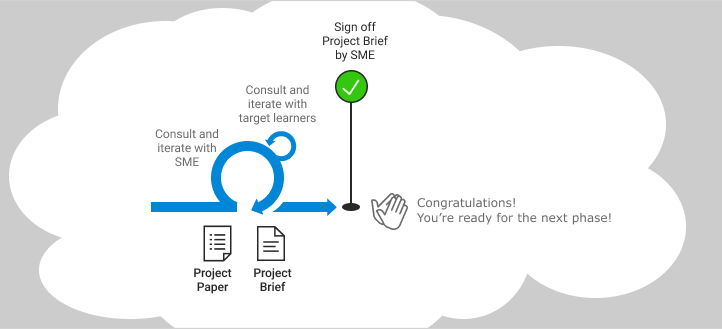
Transforming content into digital learning
Scoping the content
Discussing the Key Questions will create the basis for the next stage: now you have an agreed project brief (and it’s worth making sure this really is agreed by referring back to it as you scope) it’s time for a high level content walkthrough.
The moment of truth
To some extent, this is where the hard work begins. This is where you bring to life all the ideas that will energise your colleagues, and achieve the objectives set out in the brief.
Think of the process as a series of steps:
Step 1: Outline
Working with the aims and objectives which you have established through the key questions, you are now in a position to make a content outline.
This will include an idea of flow (what will lead to what in the progression of learning), and format (what type of content e.g. course, quiz, reference materials). You might also want to consider frequency: when will users receive content? How much space in between? Apart from learning theory considerations, there will also be business reasons for making this decision.
You should identify all the source materials you are going to be using: good to be clear about this, as you need to keep any changes or additions to a minimum. Whilst it is almost inevitable that there will be afterthoughts, you need to keep to the agreed Project Brief as far as possible.
Step 2: Training structure proposal
The outline proposal will need to be presented to the stakeholder. This should be a visual sketch of the content, in relation to both the learning objectives and JollyDeck formats: you will need to define what type of content best suits the objectives. Include all the proposed assets that will need sourcing from the stakeholder such as images, logos, videos. The outline will need to be agreed and signed off.
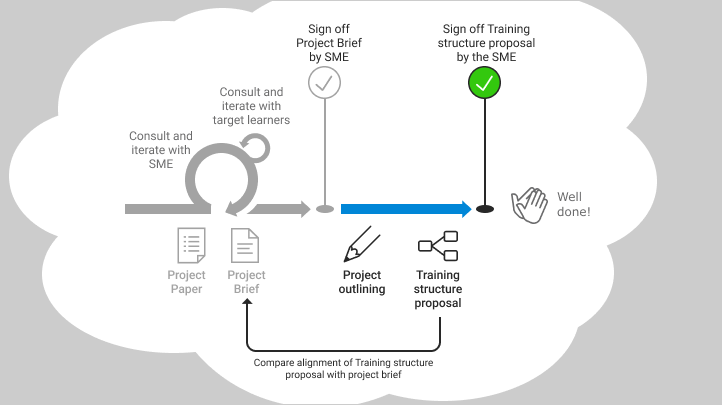
Step 3: First draft
Following agreement of the proposal, the next step is to create a first draft. This is when you flesh out your learning content in the JollyDeck content creation tool, working to the outline which has been agreed.
It can seem scary, so it’s worth remembering that anything you do can easily be changed, moved around, rewritten, until you are happy with it. Because the authoring tool is simple to use, you are free to be as creative as you can with how you order the content, punctuate with questions, and keep the learner on track with the purpose and outcomes. Use the Dos and Don’ts at the end of this document to help you.
The process:
Essentially, you are now distributing the content according to the plan you have made and agreed.
Designing a JollyDeck course? Here are some quick tips to make it attractive:
In JollyDeck, it’s very easy to try out arrangements of content, and to see what it looks like, using the preview button. As noted below, less is pretty much always more: keep it short and sweet, using more cards rather than trying to cram too much information into one.
Use card titles effectively to make it clear what the card is about. This will help users to understand the flow of learning and gain quick insight into key messages.
Punctuate with questions: these keep the attention of the user, and also give them the opportunity to check their understanding. Questions in the flow of learning can be asked to assess what the user knows already, or as a way to arouse curiosity: in this case, you can use a question to introduce learning, rather than as part of testing. Sometimes discovering that you don’t know something is an incentive to find out more.
Remember, you can move cards around very easily, if it turns out that the flow you have designed in outline will work better another way. Don’t be afraid to experiment! You can always put everything back where it was!
Tie up each Chapter / Module with some kind of “end” card: you can summarise (very briefly), link to relevant other materials, point the user forwards to what’s coming next.
Consider what assets will be used: images, video clips. You may need to ask the client for these, but it’s good if you have an idea about what will fit.
Once this is done, it will need to be reviewed so that everyone is on board with the direction. At this stage, you will be able to identify any gaps and make a list of missing materials e.g. any assets such as video or images that the client needs to provide. The JollyDeck system allows comments from invited reviewers, so that everything is transparent and agreed changes can be made. It’s important that this review is carried out by key stakeholders: the smaller the number, the better, as it may be a case of too many cooks resulting in an impasse! You also need an agreed date for comments to end, so that amendments can be agreed.
Step 4: Version 2
Now you need to make all the amendments and add in all the additional content agreed at Step 3. This will result in a version 2 which you will then offer for review. This will need a clear time frame.
Step 5: Final version
By this stage, there should not be many changes, beyond some tweaks, to the content. However, this version will still need a clear sign off, within an agreed timeframe.
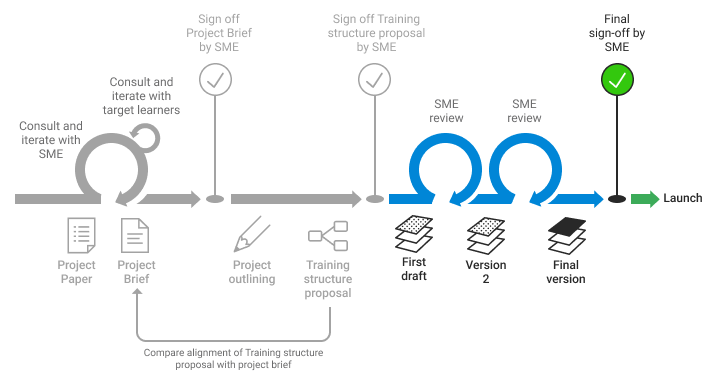
Step 6: Launch!
The workforce will have been prepared to receive the training, and reminded with appropriate comms. The JollyDeck system also invites users who have undergone the learning to comment, which can help when you are thinking of any follow up work, or your next learning campaign. You might also be looking at a broader curriculum in which you include a whole range of content which may be referred to once the mission has finished.
Some General Dos and Don’ts for Content
Dos
- Be clear that the content you have been asked to work with is related to the end point you have discussed. However painful this is, everyone should be in agreement about what you are trying to achieve.
- Get to the heart of the matter. In every piece of content, there will be a key point, or possibly points. Find that, illustrate if necessary with a convincing example. Base your questions around this, in realistic and challenging scenarios.
- Ask the right questions.
- Show the flow of the narrative: each point connects to the next, stemming from the intention of the content. If you need more detail, ask your subject matter expert.
- Less is ALWAYS more – especially now, when time pressures on everyone are acute, and a lot is expected of people. Learning should never be a huge burden. If you can trim, trim. Use checklists, bullet points, top tips, a glossary: learning which is easily digestible.
- Agree on how and what you are going to evaluate, after the training is completed. What’s the baseline? Is there any data for comparison? Do they need tests and stats, or will they be happy with manager feedback?
Don’ts
- Never trash existing content – it’s rude. And unproductive.
- Don’t over complicate: keep it simple.
- Don’t “guarantee” success, or make huge claims for what you are doing. Be realistic: you are just part of a bigger process, much of which you can’t control.

